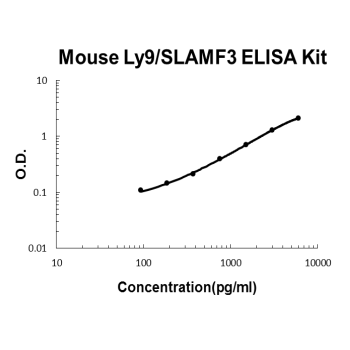Mouse Ly9 ELISA KIT (1 x 96 wells)
CAT#: EA102688
For quantitative detection of mouse Ly9 in cell culture supernates, serum and plasma (heparin, EDTA, citrate).
USD 470.00
3 Weeks*
Size
Product Images

Other products for "Ly9"
Specifications
| Product Data | |
| Format | 8x12 divisible strips |
| Assay Type | Sandwich ELISA kit of Quantitative Detection for Mouse Ly9/SLAMF3/CD229 |
| Assay Length | 3.5 hours incubations; 1 hour washing and analyzing samples |
| Signal | Colorimetric |
| Curve Range | 93.7pg/ml-6000pg/ml |
| Specificity | This kit is used for quantitative detection of Mouse Ly9/SLAMF3/CD229 |
| Sensitivity | <50pg/ml |
| Reactivities | Mouse |
| Cross Reactivity | There is no detectable cross-reactivity with other relevant proteins. |
| Components |
|
| Background | T-lymphocyte surface antigen Ly-9 is a protein that in humans is encoded by the LY9 gene. This gene is mapped to 1 H3; 1 79.54 cM. Mature human CD229 consists of a 407 amino acid (aa) extracellular domain (ECD) with two Ig‑like V-set and two Ig‑like truncated C2-set domains. It also shows a 22 aa transmembrane segment, and a 179 aa cytoplasmic domain with two immunoreceptor tyrosine-based switch motifs ITSMs. The ECD of human CD229 shares 57%‑59% aa sequence identity with mouse and rat CD229. Within the first two Ig‑like domains that are common to all SLAM proteins, human CD229 shares 24%‑39% aa sequence identity with human 2B4, BLAME, CD2F-10, CD84, CRACC, NTB-A, and SLAM. Alternate splicing generates two additional isoforms that lack the juxtamembrane Ig‑like domain or short cytoplasmic region. CD229 is expressed on T and B cells, thymocytes, and more weakly on NK cells. Homophilic binding between CD229 molecules is mediated by the N-terminal Ig‑like domain. Human and mouse CD229 exhibit cross-species binding. Antigen stimulation of lymphocytes induces CD229 clustering to sites of T cell - B cell contact. Two tyrosines in the cytoplasmic domain are required for association of CD229 with the adaptor proteins AP-2 (μ2 chain) and GRB-2 and both are required for CD229 internalization. |
| Gene Symbol | Ly9 |
| Standard Curve |

Mouse Ly9/SLAMF3/CD229 ELISA Kit Standard Curve
|
Documents
| SDS |
{0} Product Review(s)
0 Product Review(s)
Submit review
Be the first one to submit a review
Product Citations
*Delivery time may vary from web posted schedule. Occasional delays may occur due to unforeseen
complexities in the preparation of your product. International customers may expect an additional 1-2 weeks
in shipping.






























































































































































































































































 Germany
Germany
 Japan
Japan
 United Kingdom
United Kingdom
 China
China